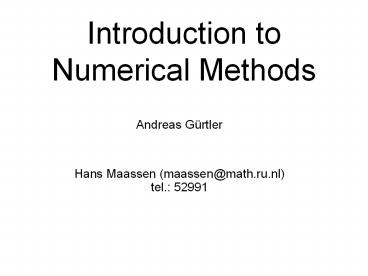Introduction to Numerical Methods - PowerPoint PPT Presentation
1 / 26
Title:
Introduction to Numerical Methods
Description:
Many problems can be formulated in simple mathematical equations ... not associative and not distributive, but they are to a very good approximation ... – PowerPoint PPT presentation
Number of Views:38
Avg rating:3.0/5.0
Title: Introduction to Numerical Methods
1
Introduction to Numerical Methods
- Andreas Gürtler
- Hans Maassen (maassen_at_math.ru.nl)tel. 52991
2
Plan for today
- Introduction
- Errors
- Representation of real numbers in a computer
- When can we solve a problem?
- A first numerical methodBisection method for
root-finding (solving f(x)0) - Practical part Implementation of the bisection
method
3
What are numerical methods for?
- Many problems can be formulated in simple
mathematical equationsThis does not mean, that
they are solved easily! - For any application, you need numbers?
Numerical Methods! - Needed for most basic things exp(3),sqrt(7),sin(
42), log(5) , ? - Often, modeling and numerical calculations can
help in design, construction, safety - Note many everydays problems are so complicated
that they cannot be solved yet ? Efficiency is
crucial
4
Numerics is about numbers
- Numerical methods Numerical approximation of
solutions to understood problems - Numerical representation of real numbers has
far-reaching consequences - Two main objectives
- quantify errorsApproximation without error
estimation is useless - increase efficiencySolutions which take years or
need more resources that you have are useless - Nowadays, many fields depend on numerics
5
- Errors
6
Numerical errors
- Roundoff error finite precisionnumerical
calculations are almost always approximations - Truncation error a calculation has to
stopExamples - Approximation (e.g. finite Taylor series)
- Discretization
- It is crucial to know when to stop (i.e. when a
calculations is converged!). To check this,
change parameters (e.g. step size, number of
basis states) and check result. - modeling error
7
Truncation errors
- Truncation errors are problem specific
- Often, every step involves an approximation,e.g.
a finite Taylor series - The truncation errors accumulate
- Often, truncation errors can be calculated
8
Roundoff errors
- Precision of representation of numbers is
finite - errors accumulate - a real number x can be represented as fl(x)
x(1?) floating point computer
representation fl(x)-x ?x
absolute error (often also ?x) fl(x)-x/x
? relative error
- Example Logistic Mapxi1r xi (1-xi)
- x0 0.7 r4
- single and double precision
9
- Computer representation of numbers
10
back to Matlab data types
- Real numbers floating point representation
double (64 bit) standard! single (32
bit) less precision, half memory - Integer signed and unsigned (8,16,32
bit)auint8(255), bint16(32767),
cint32(231-1)Integers use less space,
calculations are precise! - Complexw23i vcomplex(x,y) x,y can be
matrices! - Boolean true (1) or false (0) Strings
s'Hello World' - special valuesinf, -inf, NaN Infinity,
Not-a-Numbercheck with isinf(x), isnan(x)
11
(No Transcript)
12
(No Transcript)
13
floating point caveats
- not all real numbers can be represented as
FP0.10.10.10.10.10.10.10.10.10.1-1
-1E-16 - Floating point calculations are not
precise!sin(pi) is not 0, 1E201-1E20 is not
1 - never compare two floats (ab) directlytry
100(1/3)/100 1/3 FALSE!!! use
abs(a-b)lteps (eps2.2E-16) - be careful with mixing integer and
FPiint32(1)i/2 produces 1 as i/2 stays
integer!i/3 produces 0 ! This is much more
dangerous in C and FORTRAN etc. Solution
explicit type conversion double(i)/2 produce
s 0.5
14
- What can we solvenumerically?
15
What can we solve
- Suppose we want to evaluate f(x) with perfect
algorithm - we have FP number x?x with error ?x?f(x)
f(x?x)-f(x) ? f(x)?x (if f differentiable) - relative error
- Definition condition number
- ? gtgt1 problem ill-conditioned
- ??small problem well-conditioned
16
well- and ill-conditioned methods
- Lets try a simple calculation 99-70sqrt(2)
(?0.00505) - suppose we have 1.4 as approximation for ?2
- We have 2 mathematically equivalent methods
- f1 99-70?2 f1(1.4) 1
- f2 1/(9970?2) f2(1.4) ? 0.0051
- Condition numbers f1(x) 99-70 x ????2? ?
20000f1(x) 1/(9970 x) ????2? ? 0.5
17
what happened?
- f1 99-70?2
- f2 1/(9970?2)
- Condition number of subtraction,
additionf(x)x-a ?? -x/(x-a) ill-condition
ed for x-a0f(x)xa ?? x/(xa)
ill-conditioned for xa0 - Condition number for multiplication,
divisionf(x)ax ? xa/(ax) 1
f(x)1/x ? xx-2/(x-1) 1 well-conditioned
18
numerical disasters
- Patriot system hit by SCUD missile
- position predicted from time and velocity
- the system up-time in 1/10 of a secondwas
converted to seconds using 24bit precision (by
multiplying with 1/10) - 1/10 has non-terminating binary expansion
- after 100h, the error accumulated to 0.34s
- the SCUD travels 1600 m/s so it travels gt500m in
this time - Ariane 5
- a 64bit FP number containing the horizontal
velocity was converted to 16bit signed integer - range overflow followed
- from
- http//ta.twi.tudelft.nl/nw/users/vuik/wi211/disas
ters.html
19
Root finding a standard numerical problem
- A common task is to solve an equation f(x)0
- task find the zero-crossing (root) of f(x)
- Pitfalls f(x) might have
- no roots
- extrema
- many roots
- singularities
- roots which are not FP numbers
- roots close to 0 or at very large x
- There are different methods with advantages and
disadvantages
20
(No Transcript)
21
(No Transcript)
22
convergence
- Bisection always converges, but maybe slow
- f ? Ca,b and f(a)f(b)lt0 then pn
converges to a root p of f andpn-p ?
(b-a)/2n - Proof?n ?1 bn-an (b-a)/2n-1 and p ?
(an,bn) - convergence is linear
23
order of convergence
Let converge to p with
if positive ???? exist with
then pn converges with order ??1 linear
convergence?2 quadratic convergence
24
(No Transcript)
25
Exercise
- Implement the Bisection method in Matlab
- use it to solvex3 ln(1x)
(xgt0)
26
(No Transcript)































